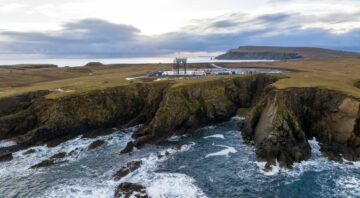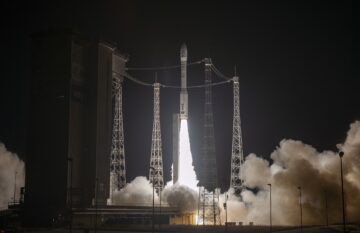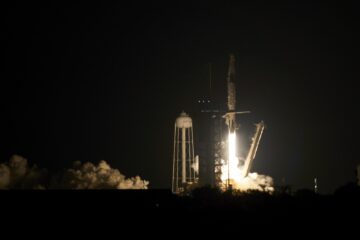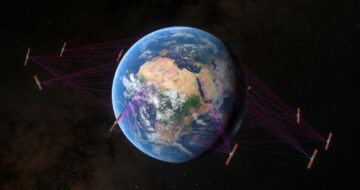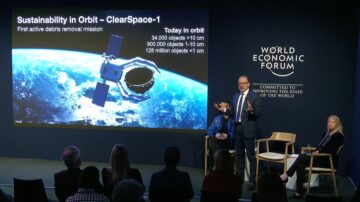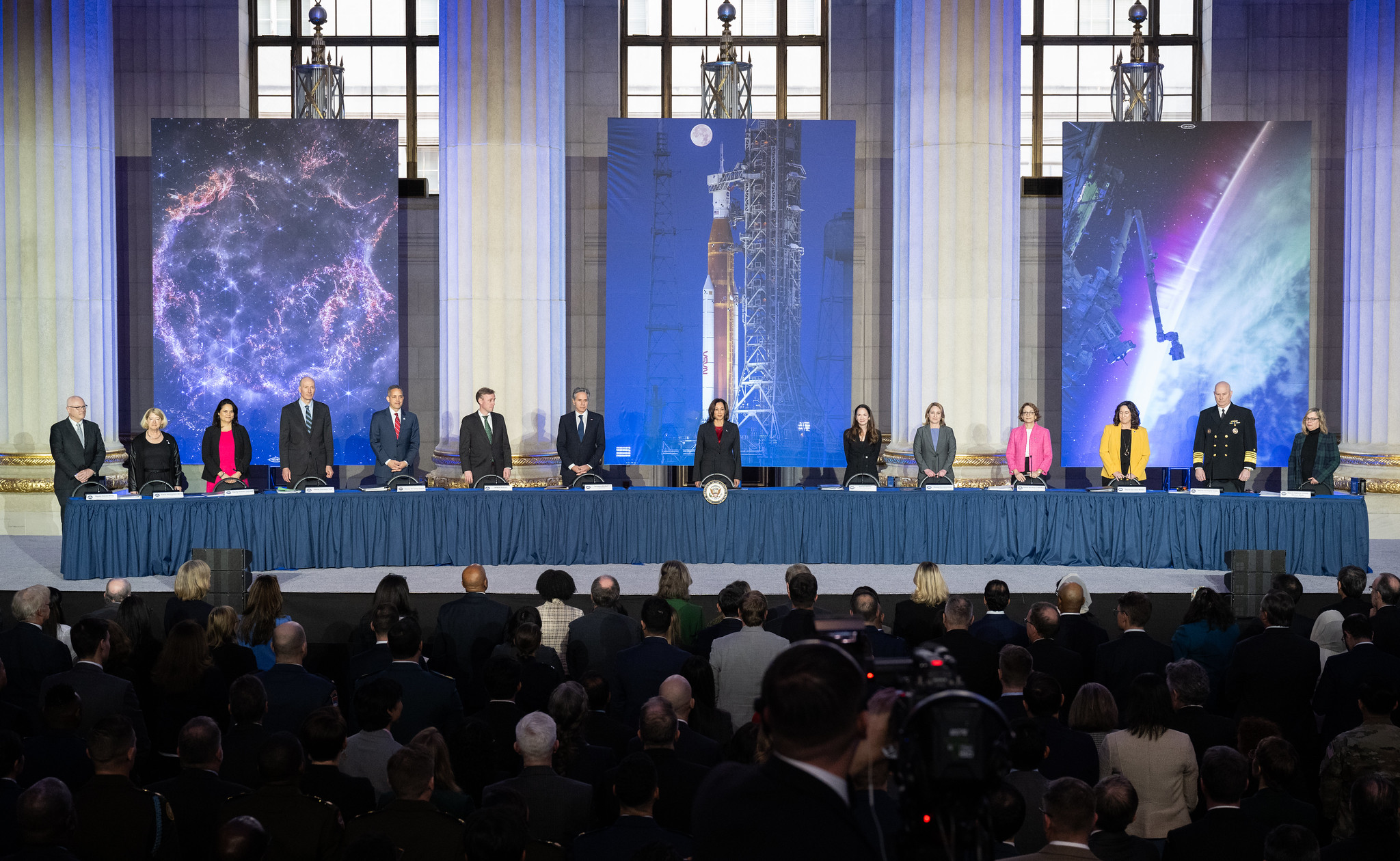
WASHINGTON — The White House used a Dec. 20 meeting of the National Space Council to discuss the importance of international cooperation but offered few new initiatives along those lines.
The purpose of the meeting, the third by the council during the Biden administration and the first since September 2022, was to highlight what the White House described in a fact sheet as “extraordinary progress in broadening and deepening international space partnerships across a range of areas.”
Those partnerships, Vice President Kamala Harris said in opening remarks, were vital to U.S. leadership in space. “In the coming years, one of the primary ways we will continue to extend that leadership is by strengthening our international partnerships.”
Her speech, and the council session that followed, largely discussed ongoing efforts in international cooperation in space. The closest thing to a new development was a confirmation that astronauts from other countries will be included on future NASA Artemis lunar landing missions.
“Today, in recognition of the essential role that our allies and partners play in the Artemis program, I am proud, then, to announce that alongside American astronauts, we intend to land an international astronaut on the surface of the moon by the end of the decade,” she said.
Neither Harris nor others at the meeting, though, offered additional details. Both NASA and international partners had long expected that astronauts from other space agencies would be included on Artemis lunar landings at some point, with both the European Space Agency and Japan Aerospace Exploration Agency in particular seeking to land its astronauts on the moon. No astronauts from any agency, including NASA, have been assigned to missions after Artemis 2, which will fly around the moon as soon as late 2024.
The meeting instead largely discussed ongoing initiatives in international cooperation, such as the Artemis Accords and U.S.-led efforts to ban destructive testing of direct-ascent antisatellite (ASAT) weapons. The meeting also highlighted a previously announced partnership between NASA and the Italian space agency ASI to fly a NASA Earth science instrument, the Multi-Angle Imager for Aerosols (MAIA), on an Italian satellite. The U.S. Agency for International Development will work with NASA to distribute data from MAIA to governments and organizations in Africa and South America.
Officials said at the meeting they would continue those efforts. Secretary of State Antony Blinken cited “significant progress” on the ASAT testing ban, with 36 countries having joined the United States since Harris announced the testing moratorium in April 2022. “Next year, we will continue our diplomatic efforts to establish this as an international norm,” he said.
During the meeting, Phil Gordon, national security adviser to the vice president, instructed council members to carry out several efforts related to international cooperation that included continued outreach on an ASAT testing ban, implementation of the Artemis Accords “in practice” and a plan to better use space in support of international capacity building. Gordon chaired the meeting in the absence of Harris, who left immediately after her opening remarks.
Harris and others noted that all 33 countries who signed the Artemis Accords were in attendance at the council meeting. The only non-American to speak, though, was Canadian Space Agency astronaut Jeremy Hansen, who was assigned earlier this year to Artemis 2.
“NASA could have chosen to do this alone, but they intentionally chose to include Canada and a growing list of international partners,” he said of the Artemis program in remarks introducing Harris. “It is not only sincerely appreciated but it is urgently needed in the world today.”
U.S. competitiveness in space
While international cooperation was the central theme of the speech, the meeting also discussed American competitiveness in space. That included responding to what officials said were growing military threats from China and Russia.
“The threats that we’re monitoring include physical threats, electronic warfare and cyber threats to ground sites and space-based infrastructure,” said Avril Haines, director of national intelligence. “China and Russia in particular continue to invest heavily in, and are fielding, counterspace weapons.”
Gordon, in his role as chair of the meeting, directed Haines and her office to develop “minimum cybersecurity standards” for space systems. That would presumably build upon Space Policy Directive 5, issued by the Trump administration in 2020 for cybersecurity of space systems.
Another task from Gordon was for the government to review space-related export controls to ensure both the competitiveness of U.S. industry while protecting national security interests. Don Graves, deputy secretary of commerce, said that review, including policies and the contents of control lists, was in progress.
The administration also used the meeting to announce a new policy framework for mission authorization, guiding how the Commerce Department, Transportation Department and other agencies will provide authorization and continuing supervision of commercial space activities not licensed today. That policy framework is a companion to a legislative proposal issued by the White House in November that would provide the needed statutory authority for that process.
“This proposal was thoughtfully developed by agency experts across the government in collaboration with the National Space Council,” said Polly Trottenberg, deputy secretary of transportation, at the council meeting. “These authorities will help ensure the U.S. remains a global leader in aerospace safety and interoperability.”
- SEO Powered Content & PR Distribution. Get Amplified Today.
- PlatoData.Network Vertical Generative Ai. Empower Yourself. Access Here.
- PlatoAiStream. Web3 Intelligence. Knowledge Amplified. Access Here.
- PlatoESG. Carbon, CleanTech, Energy, Environment, Solar, Waste Management. Access Here.
- PlatoHealth. Biotech and Clinical Trials Intelligence. Access Here.
- Source: https://spacenews.com/national-space-council-meeting-emphasizes-international-cooperation/
- :is
- :not
- 20
- 2020
- 2022
- 2024
- 33
- 36
- a
- across
- activities
- Additional
- administration
- adviser
- Aerospace
- africa
- After
- agencies
- agency
- All
- alone
- along
- alongside
- also
- am
- america
- American
- an
- and
- Announce
- announced
- Antony Blinken
- any
- appreciated
- April
- archives
- ARE
- areas
- around
- Artemis
- Artemis program
- AS
- assigned
- astronaut
- At
- attendance
- Authorities
- authority
- authorization
- Ban
- BE
- been
- Better
- between
- biden
- Biden Administration
- both
- build
- Building
- but
- by
- Canada
- Canadian
- Capacity
- carry
- central
- Chair
- China
- chose
- chosen
- cited
- closest
- collaboration
- coming
- coming years
- Commerce
- commercial
- companion
- competitiveness
- confirmation
- contents
- continue
- continued
- continuing
- control
- controls
- cooperation
- could
- Council
- council members
- countries
- cyber
- Cybersecurity
- data
- decade
- Department
- deputy
- described
- details
- develop
- developed
- Development
- diplomatic
- directed
- Director
- discuss
- discussed
- distribute
- do
- don
- during
- Earlier
- earth
- efforts
- Electronic
- emphasizes
- end
- ensure
- essential
- establish
- European
- European Space Agency
- expected
- experts
- exploration
- export
- extend
- fact
- few
- First
- followed
- For
- Framework
- from
- future
- Global
- gordon
- Government
- Governments
- Ground
- Growing
- had
- Have
- having
- he
- heavily
- help
- her
- Highlight
- Highlighted
- his
- House
- How
- HTTPS
- i
- immediately
- implementation
- importance
- in
- include
- included
- Including
- industry
- Infrastructure
- initiatives
- instead
- instrument
- Intelligence
- intend
- intentionally
- interests
- International
- Interoperability
- introducing
- Invest
- Issued
- IT
- Italian
- ITS
- Japan
- joined
- jpg
- Kamala Harris
- Land
- landing
- largely
- Late
- leader
- Leadership
- left
- Legislative
- legislative proposal
- Licensed
- lines
- List
- Lists
- Long
- Lunar
- meeting
- Members
- Military
- Mission
- missions
- monitoring
- Moon
- moratorium
- Nasa
- National
- national security
- needed
- New
- new policy
- no
- nor
- noted
- of
- offered
- Office
- officials
- on
- ONE
- ongoing
- only
- opening
- organizations
- Other
- Others
- our
- out
- outreach
- particular
- partners
- Partnership
- partnerships
- PHIL
- physical
- plan
- plato
- Plato Data Intelligence
- PlatoData
- Play
- Point
- policies
- policy
- president
- previously
- primary
- process
- Program
- Progress
- proposal
- protecting
- proud
- provide
- purpose
- range
- recognition
- related
- remains
- responding
- review
- Role
- Russia
- s
- Safety
- Said
- satellite
- Science
- secretary
- security
- seeking
- September
- session
- several
- she
- sheet
- signed
- since
- sincerely
- Sites
- some
- Soon
- South
- South America
- Space
- space-based
- speak
- speech
- State
- States
- strengthening
- such
- supervision
- support
- Surface
- Systems
- Task
- Testing
- that
- The
- the world
- theme
- then
- they
- thing
- Third
- this
- this year
- those
- though?
- threats
- to
- today
- transportation
- trump
- Trump administration
- u.s.
- United
- United States
- upon
- use
- used
- vice
- Vice President
- vital
- was
- ways
- we
- Weapons
- were
- What
- which
- while
- white
- White House
- WHO
- will
- with
- Work
- world
- would
- year
- years
- zephyrnet

